#associated with the white communists
Explore tagged Tumblr posts
Text
So goddamn frustrated with the white communists who keep coopting the palestine solidarity meetings to either wage little recruitment turf wars (the stalinists) or turn every single point into a plug for their worker's revolution in sweden (the marxists).
The palestinian youth movement people literally Walked Out of the meeting today in frustration. One guy who survived the syrian revolution tried to tell them to stop and why this was not good and they just bulldozed over him. A black woman tried to talk about how as a person of color in sweden she feels like their voices are often suppressed, and this guy kiterally replied that he doesnt think race has anything to do with it. I feel like im in a bad parody.
Tried to talk to the marxists about how we are supposed to be supporting palestinian right to self determination and why you shouldnt show up to a solidarity meeting and alienate the people you claim to support by making it all about you and your ideas, and the most dogmatic of these guys (same one who said race has nothing to do with it) literally said no instead of toning it down he thinks they need to step it up with trying to recruit withing the solidarity umbrella org. Like...
Besides being the kind of contrarian rhetoric style thats the most frustrating (you say tone it down and he says no in fact turn it up), theyre just completely unable to work in an umbrella organization because they cant stop hounding on their socialist revolution long enohgh to build broad solidarity or even focus on the immediate crisis at hand.
This dude is completely convinced that he, personally, will be the vanguard of the revolution and wont stop about how everyone globally needs to implement his methods. Talking about how the palestinians should be centered in the discussion of their own struggle goes completely in one ear and out the other.
I'm so fucking frustrated and dont want peoole to think i'm associated with them its such bad white saviorism and completely dogmatic tunnel vision i wanna punch things
#just some ranting#meeting was 2.5 hours and sooo much of it was discussion on why nobody bit tue hardcore communists want the umbrella org tovbe#associated with the white communists#your movement is completely 100% white and none of the immigrsnts want to be associated with you#your white savior techno utopia revolution is just imperialism 2.0
1 note
·
View note
Note
Did you know you're aaaaaawwweeeessome?
Started making like. An Actual Set. With structure and rarities and stuff. Themed around the modified keyword, with different modifications. Here's the white commons

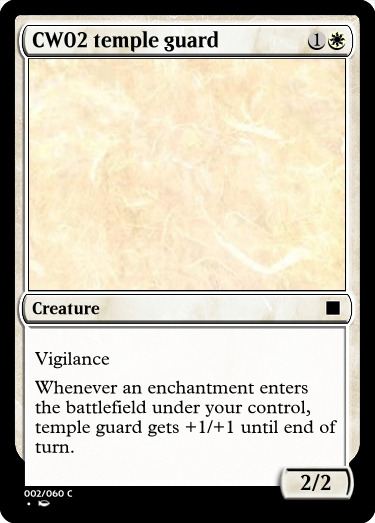



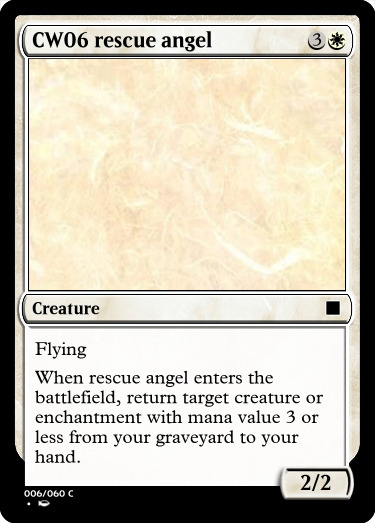




#asks#custom cards#names are temporary#the flavor is a work in progress#each of the 3 modifications is associated with a different group/ideology#(not sure if ideology is the right word)#but like +1/+1 counters are all about teamwork and collective strength and creatures#auras have a “serving a higher power” idea that could be government or religion#equipment are about individual strength. no kings or allies just you and your sword#i've assigned the modifications to colors but i'm not sure about the actual worldbuilding yet so there's no real names or flavor text#equipment is grixis (blue-black-red) because they're the most individualistic colors#auras are bant (green-white-blue) because they're the most fitting for working for a higher power/greater good#and +1/+1 counters ended up being aggression (black-red-green-white) to balance everything out#i wanted each color to have 2 factions so even though black is a bad fit for teamwork it's even WORSE for “greater good”#who are these factions? what do they do?#idk#the equipment faction probably isn't an actual group#their whole thing is that they're individuals#maybe the plot is that everyone is getting aggressive#aura-church is getting more oppressive equipment-randos are bandits or something counter-peeps are starting a communist revolution#and none of them can ignore the others anymore so war happens#also i've made the blue commons already#i found some nice articles by mark rosewater about set design called nuts & bolts#especially the ones on design skeletons#the old one is outdated and the new one is about large sets so i had to improvise#but it works#i'll finish the commons then make uncommons#figure out the flavor somewhere along the way#and i GUESS i'll do rares too. if i have to#maybe i won't
2 notes
·
View notes
Text

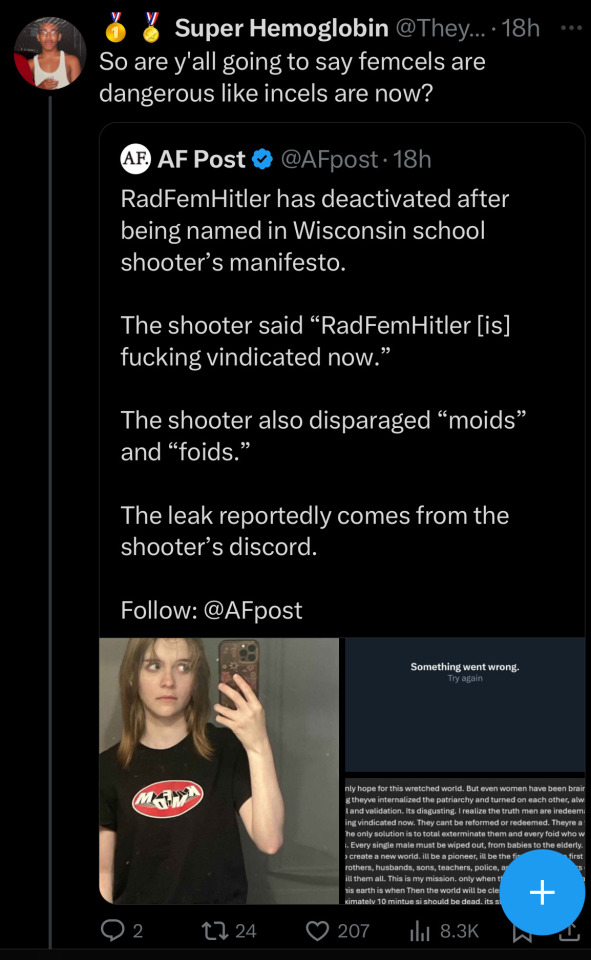
There has been so much push, especially in supposed leftist spaces, to liken radical feminism/feminists to incels/inceldom. And it actually makes me want to bash my head into a wall. I don’t know if you guys are aware but there was a mass shooting at a high school yesterday. And the perpetrator was a girl. And conservatives were instantly trying to leech onto her being apart of whatever group. Trans, lesbian, communist etc. she is a biological heterosexual female. A biological heterosexual female that was entrenched in alt right fascism who formed an entire identity around it. And her digital footprint shows that. Yet there’s “leftists” that are parading around a fake excerpt from her manifesto (shared by an anti feminist incel mind you) claiming she was a radfem man hater who wanted to exterminate men and have women rule the world. And also wanted to exterminate women who worshipped men. Meanwhile this is her

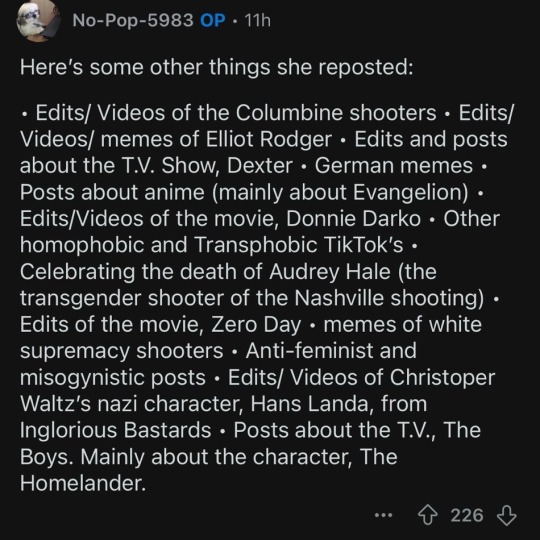

Because nothing says man hating radfem like reposting memes about an incel who targeted women in a mass shooting. And stanning male mass shooters. Everything about this girl indicates the real life consequences of these alt right cesspools that are being formed all across the internet infecting children with these ideologies. She literally posted a picture of herself holding a white power symbol in the bathroom right before committing the shooting. There’s so much conversation to be had about white supremacy and fascism. And how it’s dominating online spaces and indoctrinating young people who are living their lives in these echo chambers and becoming violent, apathetic individuals. But do leftists wanna talk about this?? Noooo they’d rather disparage radical feminism and grasp at straws to make this some male equivalent to incel related shootings.
I’m linking a report that was done on incel forums to really show you how ridiculous it is when these people try so desperately to associate radical feminism with inceldom. Or try to claim that redfems are “femcels” because what’s anti feminist rhetoric if not insinuating feminists are so angry at men because they need some dick 🤩
This was a very informative look into the incel community and their activities online. The things they say, promote, and enable. And yet so many people have the gall to in any way shape or form liken radfems or women who hate men to them. It actually makes me want to pull my hair out
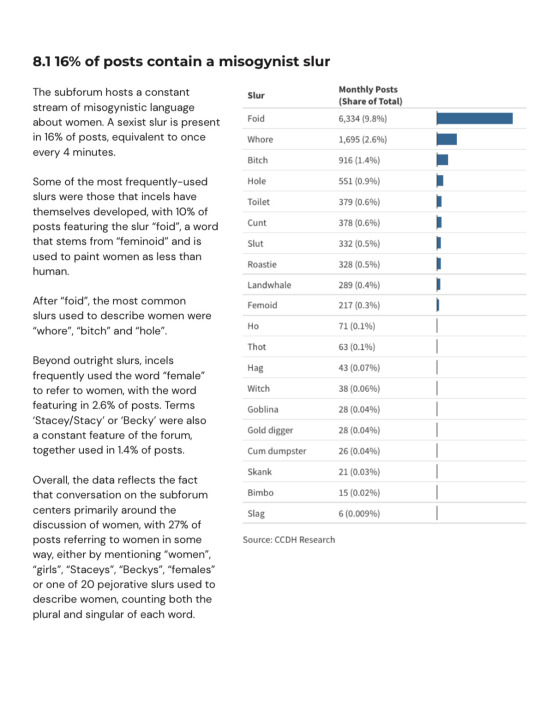


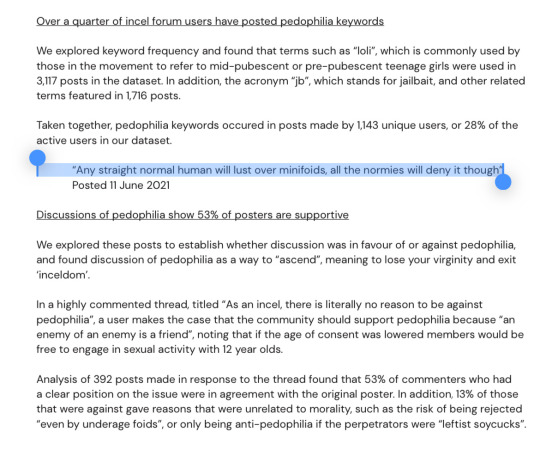
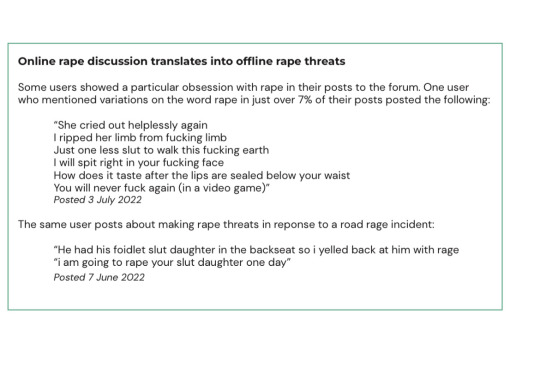
Like you really think this, and the community that it’s amassed, is in any way comparable to women hating men as a response to men hating and oppressing women including from these very same men… That actually it’s because these women are ugly and can’t get a men and now they’re vindictive toward men (anti feminism rhetoric as old as time). Or even that it’s not really that they’re not like incels in the sense that they can’t get relationships/sex, but exhibit behavior anywhere near this depravity. Very unserious.
#radblr#radical feminist safe#radical feminism#radfem#men hate you#i hate men#moids#moid moment#radical feminists do touch#radical feminist community#radical feminists please touch#radical feminists please interact#radical misandrist#radical feminst#radical feminists do interact
483 notes
·
View notes
Text

Except that this is bullshit. Only 31% of Israel's total population is Ashkenazi Jewish, do you actually comprehend that? A majority of Israel is Mizrahi, which is Middle Eastern. Nothing to do with Europe, or imperialism, or whiteness. They're Middle Eastern Jews.
They're Levantine. We know this, because we use science, and our eyeballs, and archaeology and history, to determine this shit. You can lie and say some Jews are light-skinned which means they're white. Y'all turn around and praise the IRGC and call Iran an Arab country.
There are some Iranians who are 100% white, that's how light-skinned they are. You still would call them Persian, or Arab. You, your conception of whiteness, your racializing of Israel and the Middle East, is fundamentally fucking racist and purporting disgusting Nazi-era bullshit.
Jews are indigenous to Judea, or Israel. Ashkenazim too, they are also Levantine, which again we know because of Science. It isn't imperialism or colonialism or whatever bullshit you're espousing when the indigenous population of a land returns to their land. Most of Israel didn't even exist before Jewish immigration, most of it was uninhabited. Tel Aviv didn't exist before, Holon, Netanya, many other cities.
You have swallowed a bunch of IRGC and Russian propaganda and bullshit, and it's doubly ironic because you claim to oppose colonialism whilst parroting Russian anti-Western imperialism talking points (Antizionism, associating Zionism to imperialism, the Protocols of the Elders of Zion, all originated in Soviet Russia).
Russia, which is the largest mass of colonized land on PLANET EARTH. You people who claim you are Marxist, Leninist, Maoists, who whinge and moan about genocide and atrocity. Communist Russia has killed 61 million people since it's inception. Stalin directly killed 6 million people. Mao Zedong starved 80 million people to death.
And you want to lecture Jews about Israel. Get the fuck out.
#palestine#israel#jumblr#antisemitism#i/p#gaza#leftist antisemitism#politics#weemie#jewish history#jewish#jewish tumblr#jewblr#communism#fuck communism#tankie punks fuck off#russia#ukraine#stand with ukraine#land back#anti-indigenous racism#racism#leftist hypocrisy#antizionism is antisemitism#the jews are tired
197 notes
·
View notes
Text
Hot Take Incoming The more I read about Neo/New Bundism, the more I'm convinced that it's an ideology that is based on a weird mix of Ashkenazic white guilt, "yearning for the shtetl", and identifying with Yiddish culture over Jewish culture because the former emphasizes secularism while the latter does not (which belies that fact that Judaism has multiple ways to engage with it and you don't need to be religious).
This last part is especially important to understand as in the West, Judaism is emphasized as one of the Big Three religions even though it's one of the smallest in the world. Many of us are taught that Judaism is just proto Xtianity or Islam, and depending on where you live and your community you absorb that. Especially if your family is non-practicing and there isn't much of a Jewish community and culture for you to interact with growing up. Many of our holidays, cultural norms, and so on are associated with Xtianity and framed in regards to a Cultural Xtian society. Hence why I think so many young secular Jews feel that they can't actually connect with Judaism because the narrative they have from Xtian society plus their disconnect from Jewish society means they perceive Judaism through the Xtian religious perspective.
If Cultural, religious, and lax Xtians are this way, then sure Judaism is as well since Xtianity is based on it, right?
That's the mindset I've seen over and over.
This is further exacerbated by the immigrant communities in the North Eastern USA (NY, PA, NJ) that had massive moments of cultural exchange and assimilation. Deli culture in the North East is a mix of Italian and Jewish cultures. Historically, Italian and Jewish communities allied and mixed in the early 20th to the point where it's a stereotype. And if you don't believe me then let me point to Harley Quinn in pop media, any of the organized crime families and the start of Las Vegas, or the fact that you can get a cheesesteak in a Jewish deli in PA.
So it makes sense that Bundism is having a revival of sorts into it's Neo era. It's a socialist ideology that emphasizes progressive ideals that man of us agree with. But Bundism also emphasized secular Judaism by putting Yiddish culture at the forefront. It was a way to be Jewish without being religious, and if you have any hang ups on religious practice then it makes sense as to why this ideology might be attractive. However, there is a failure to acknowledge that the largest Bund, and successor populations/groups, had to give a pound of flesh repeatedly to "prove" that they were loyal because of the old dual loyalty antisemitic conspiracy. And that was never enough as these groups were wiped out after their governments were done with them.
(Note: some of the most ardent anti-communist Jews were ex-Soviet citizens who managed to escape and witnessed all of this firsthand)
Neo/New Bundism comes across, especially since Oct 7th, as an aggressive "yearning for the shtetl" that rehashes the compromises the Old Bund was willing to give the USSR regarding its Judaism by embracing and emphasizing Yiddish culture instead.
For example; look at all the literature and examples regarding JVP. They had the seder plate incident back in the Spring, have had literature that told Jews not to pray and/or speak in Hebrew but in English or Arabic, and have rabbis that denigrate and dismiss Jewish culture and history (as well as so many other incidents and issues). All they need to do is tell Jews that they should actually be secular socialists and speak Yiddish instead and you'd have one of the cornerstones of Bundism.
It didn't work during the early to mid 20th century, and it won't work now.
But nostalgia is a helluva thing.
And so it comes across as this highly aggressive rejection of Israel and everything it stands for, whether true or falsely attributed to it, because it's not about the Jewish connection to Israel but the Jewish connection to a more immediate loss: Yiddish culture, which was decimated and destroyed in the 20th century. This is especially true when talking to Ashkenazic Neo Bundists as their family histories, like mine, start and stop with the Shoah.
Consider that the Bund were one of the largest Jewish organizations in the Pale, the resulting Yiddish community in said region were the largest in the world, and they organized and fought the Nazis, then it makes sense as to why the loss would be so poignant for many and grabbing ahold of the ideology to create a connection makes sense. I know for me that if I were to dive into everything Yiddish I would develop a greater appreciation for my family and where I come from even with the loss of knowledge caused by the Shoah.
If you further consider that it's a secular ideology that puts socialism first, then Yiddish, and then Judaism last, then it makes sense as to why you see so many anti-Zionists emphasize the "Israel killed Yiddish" talking point (which I haven't seen in months, but I remember it being a thing up until the Spring). The ideology does not emphasize identifying with Judaism and Israel, but with Yiddish culture and institutions.
There's nothing wrong with this per se, but it isolates an aspect of the Jewish community and says "you're different from the rest of them" while at the same time emphasizing that they should assimilate into the rest of the world. And let's be honest, because it is a European based ideology it was emphasizing assimilation into Western civilizations of European descent.
It therefore makes sense as to why Neo Bundists don't identify with Israel and/or refuse to identify with it. They identify with the European aspect of their history and not with the Middle Eastern. The European connection is immediate and direct, the Middle Eastern is distant and cultural. I understand this position as its Biological Altruism theory in practice, but it does fail to take in the larger "ecological" community that is being Jewish.
Part of the ideology and its adherents also blame Israel for not reviving or reconstituting the Yiddish community and culture, which is ironic because that would be focusing on a very European subculture of Judaism (and anti-Israel activists continuously yell that the country is a White European Colony). Ironically, this "Israel killed Yiddish" point either fails to take into account or lies through omission that the Nazis and USSR killed the largest Yiddish cultural centers and populations in the 20th century and that Yiddish culture in the USA has faded away over time as more and more ethnicities and cultures have assimilated and torn down their metaphorical, and sometimes very real, isolationist walls.
Unfortunately Neo Bundism focuses on the pre-WWII aspects of Bundism. I've personally talked to a bunch of Neo Bundists, and witnessed/read on social media their writings and interactions, and in each instance they emphasize that Bundism has been around since before WWII, was a widely supported ideology, and it stood opposed to Israel and Zionism.
Except they rarely talk about Bundism post WWII. After WWII and with the establishment of Israel it dropped the opposition position. Israel became an extant country and opposition to its existence didn't make sense anymore. It dropped the anti-Zionism, but still emphasized doikayt. It emphasized that Israel should adhere to the progressive Bundist ideologies of economic, social, racial, and political equality and equity. Hell, there was even an Israeli Bundist organization.
Hence why the last extant Old Bundist organization in the world, Melbourne's Jewish Labour Bund, has an issue with New/Neo Bundism. The Melborune JLB is the last existing Old Bund group in the world with all others have closed down in prior years or decades. MJLB acknowledges the October 7th attack by Hamas and the violence imposed on Palestinians by Israel. It acknowledges suffering on both sides. New/Neo Bundist organizations rarely, if ever, do this and instead commit to a Holocaust Universalization like position regarding Gaza while omitting the terrorist attacks.
Furthermore, the Neo/New Bundist organizations do not discuss the issues that define Bundist ideology, such as economic and social issues, but instead emphasizes the anti-Zionist position. This reduces it to a one trick pony that misses the point entirely (paraphrasing Dr. Ringelbaum who is President of JLB here). The focus on pre-WWII Bundist ideology echoes the sentiments of Bundist groups that did not want to change their ideals and positions afterwards, which led to them becoming defunct. The Neo/New movement is repeating the same mistakes that led to the dissolution of the movement at large and resulted in the ideology being relegated to the wings with no real voice.
It is also important to note that the majority of the Neo/New Bundist movement is under 30, with a lot of them being undergrad age. As someone who teaches this age bracket I will say that they're passionate but overconfident. They're informed but also ignorant. They're sympathetic and empathetic, but easily misled. I was too at that age.
And like any movement, Neo/New Bundism is going to have its growing pains. I think if it is to continue past this conflict and does not fizzle out then the movement and associated organizations need to reflect on what they actually mean outside of anti-Zionism. Because as of right now and for the past few years of its inception, and the brand new groups, that is all they've been. That's not fighting for labor, social, racial, political, and economic rights. That's repeating the same mistakes as the Bund in the early 20th century did. It's cutting off your nose to spite your face.
At this point in time myself and others don't trust Neo/New Bundists because why would we? The movement has shown that it's anti-Israel positioning is more important to them than anything else. This means they ally, like the Old Bund did, with antisemites who want to harm all of us. The movement just happens to give them permission to be extremely and violent antisemitic by using "as an anti-Zionist Jew" as a permissible framework. Just like the Old Bund did pre-WWII.
You're not doing anything new or innovative or helping the diaspora. You're following in the footsteps that led to more deaths of our people.
Please re-examine where you stand and what you stand for. It's been done before and we need to learn from history. Not repeat it.
#jumblr#antisemitism#Neo Bundism#New Bundism#Neo/New Bundism has problems and Old Bundism agrees#Long post#Hot take#AVTJ's very tired thoughts#Brain rambles
155 notes
·
View notes
Note
What is the origin (and meaning) of the flag adopted by the Second Spanish Republic? The choice of colors seems rather unconventional to me...

The purple stripe was adopted officially by the second republic as a nod to Castille, a big region in the middle of Spain:
Hoy se pliega la bandera adoptada como nacional a mediados del siglo XIX. De ella se conservan los dos colores y se le añade un tercero, que la tradición admite por insignia de una región ilustre, nervio de la nacionalidad, con lo que el emblema de la República, así formado, resume más acertadamente la armonía de una gran España
Translation:
Today the flag adopted as the national one towards the mid 19th century is folded. From it, the two colors remain and a third one is added, which tradition takes as the insignia of an illustrious region, nerve of nationality, and therefore the Republic's emblem, thus formed, contains more accurately the harmony of a great Spain.
The purple as a symbol of Castille comes from a misunderstanding of what the 1520 revolt of Comuneros used as a symbol. The color of Castille has always been described as crimson, which is sometimes confused to have a more purplish hue. While it has been shown the Comuneros used a red cross as opposition to the imperial white cross, popular wisdom was that they used purple, and it gradually became an actual color used by Castillian regionalists.
Note on the Comuneros, Castillian regionalism, and some trivia about the Republic's coat of arms under the cut:
The revolt of 1520 happened in the context of emperor Carlos 1st (5th of the HRE) barely speaking the language, favoring politically and financially the Flemish court with the wealth extracted from the Americas, and also funding very expensive wars that didn't even have anything to do with the Crown of Spain. He was also a corrupt monarch who raised taxes. Both the nobility, which wanted more participation in governing, and the merchant/middle strata (including an embryonic bourgeoisie!), which were being overburdened with taxes, revolted against the king. The focus of the revolt and where they had more strength was in Castille, and one of the forms of territorial organization of the Crown of Castille was the Communities, which is where the name comes from. The people who participated in the revolt as well as the modern political movements that claim to descend from them (more on that later) are known as Comuneros, which I'd translate as Communards.
I won't go into very much detail, and this is still a debated topic. The character of the revolt had many axes, one of which was the more popular elements (peasants, bourgeoisie, artesans, merchants, etc), to the point that it is considered by some to be some of the first if not the first attempt at a bourgeois revolution in Modern Spain, another was the more opportunistic axis (fiscal reform, the nobility, etc.). What matters is that a very strong narrative has grown around the 1520 revolt, beginning in the Golden Era of the 17th century and its literature, that of a popular revolt and of a relatively old and legitimizing ancestor for the popular movements in Castille.

This is the Comunero flag nowadays, notice the purple field as a reclamation of this color as a Castillian symbol. What's of more interest to me is the following flag:

This flag and the movement it represents, Izquierda Castellana (Castillian Left) emerged after the end of the dictatorship, not as a separatist kind of regionalism, but as one that appreciates the history and culture of Castille. The red star is a very overt influence from communists and socialists, which are, as far as I'm aware, quite present in Izquierda Castellana.
So purple in Spanish politics has been, ever since the ~16th/17th century, associated with the popular movements and tendencies of Spain, particularly those in the peninsula's center. It became even more cemented in this role after the Second Republic adopted it, sort of hitchhiking the much bigger Republican tendencies.
The Second Republic's coat of arms subtitutes the monarchich crown for a castle in the shape of a crown, both as another nod to Castillianism and to symbolize the replacement of the monarchy for the people themselves

In the short life of the Republic, its symbols found their way into a lot of places or replacing old symbols, and almost all of them were destroyed during the dictatorship. The most prominent exception is the facade of Madrid's main train station, Atocha (originally named Estación del Mediodía (midday station)):


Notice it perched on the clock? I don't know if it went unnoticed, or if they did not care enough (unlinkely). It is possible it went unnoticed because I can't find information on it. Other examples of this castle-mural crown remaining in Madrid are:

This lightpole right in front of the Royal Palace

And this massive coat of arms on the facade of the Bank of Spain
64 notes
·
View notes
Text
MATTHEW LEE, AAMER MADHANI, and JILL COLVIN at AP:
WASHINGTON (AP) — Job-seekers hoping to join the new Trump administration are facing a series of intense loyalty tests, with White House screening teams fanning out to government agencies to check for “Make America Great Again” bona fides and carefully parsing applicants’ politics and social media posts. President Donald Trump has long said he believes the biggest mistake he made during his first term was hiring what he considered to be the wrong kinds of people. Now, aides are working aggressively to ensure the government is filled only with loyalists. Negative social media posts have been enough to derail applications. Those seeking jobs have been told they will have to prove their “enthusiasm” to enact Trump’s agenda and have been asked when their moment of “MAGA revelation” occurred. One federal employee said they briefly considered buying Trump’s crypto meme coin in case the president’s team asked about their voting record.
The intense screening has led some federal workers to question whether Trump’s team cares more about loyalty than competence. There is concern that his team is ousting foreign policy and national security diplomats and others who could offer the administration expertise and institutional knowledge at a time of conflict worldwide. Trump officials have made no secret of their intention to fill the administration with hires sharing the president’s vision. They began checking potential staffers shortly after Trump launched his campaign and have continued since he won. An application form on the Trump transition website, for instance, asks candidates, “What part of President Trump’s campaign message is most appealing to you and why?” according to a link obtained by The Associated Press. It also asks how they had supported Trump in the 2024 election — with choices including volunteering, fundraising, door-knocking and making phone calls — and to submit a list of their social media handles. [...]
Screening teams deploy across federal agencies
Some officials have referred to the newcomers sent by the White House to federal agencies disparagingly as “MAGA commissars,” a reference to Communist Party officials from the former Soviet Union. They are generally young and many do not appear to have particular expertise or background in the portfolios of the agencies in which they are working, according to three U.S. officials, who, like others, spoke on condition of anonymity for fear of reprisals. They said the screeners seem to be looking for even the slightest divergence between candidates and Trump’s MAGA movement and “America First” policies. A negative social media post or a photograph with a Trump opponent has been enough for some applications to be rejected or put on hold for further review. One official said he and several colleagues from various agencies had been told that even if they passed the initial vetting process to be admitted into the applicant pool, they would still need to prove their bona fides and convince interviewers of their “enthusiasm” to put in place Trump’s policies, including by providing references from people whose loyalty had already been established. This official said one colleague who made it to the interview stage was asked when that person’s moment of “MAGA revelation” had occurred. [...]
Checking for MAGA alignment
Trump administration officials had made clear plans for a robust screening process that would ensure all officials inside the administration — and especially those who could help shape policy — were aligned with Trump’s agenda, according to U.S. government officials and people familiar with their planning. One longtime government employee said he ran into a senior Trump administration official in December who told him that Trump’s team would look to be more thoughtful about how they were vetting appointees and even detailees. Those are nonpolitical, career experts on topics that range from counterterrorism to global climate policy who are loaned to the White House from other agencies for extended assignments. All appointees, the person said, would be issued questionnaires to ensure they were fully committed to Trump’s agenda. The AP has reported that career civil servants who work on the White House National Security Council have been questioned by senior Trump administration officials about which candidate they voted for in the election, their political contributions and whether they have made social media posts that could be considered incriminating by Trump’s team. On Wednesday, roughly 160 NSC detailees who worked in the Biden administration were told that they were being sent home so Trump’s team could conduct a review to ensure its personnel aligned with Trump’s agenda.
AP reported this weekend that anyone seeking a job at the White House must show loyalty to the anti-American MAGA agenda if they want to be hired on.
20 notes
·
View notes
Text
L.A. On Fire
The Palisades Fire erupted on Tuesday morning, many pointing out suspicious circumstances.
Grok, the X (formerly Twitter) artificial intelligence app, summarizes these suspicions based on user posts:
Multiple Fire Origins: There were reports of multiple fires starting in different areas at the same time, suggesting the possibility of intentional ignition. This pattern points towards arson, which could indicate a coordinated effort rather than a single accidental event.
Suspicious Timing and Location: The fire started in a backyard on a no-burn day, which is highly suspect given the wind conditions that day. This suggests that whoever started the fire did so knowing the potential for rapid spread due to the 100 MPH winds.
Arson Suspicions and Theories: Unofficial reports and social media posts mention a person of interest seen near the origin of the fire, indicating a possible arsonist who might have used an electrified mountain bike to escape. There are also theories suggesting political or personal motives behind the fire, like an unemployed firefighter or political figures being blamed.
Controversy Over Fire Management: There were allegations of mismanagement, including issues with water supply for fire hydrants and the decision to ground aerial firefighting resources, which could have exacerbated the situation.
Conspiratorial Theories: Users have suggested various motives, including disaster capitalism, where the government or associated entities would benefit from the destruction and the rebuilding process. Some have linked this to political figures or insurance companies, proposing that the fire was a calculated move to either shift public focus or to profit from insurance claims.
Ex-Newsmax and ex-OANN White House correspondent Emerald Robinson posted on the platform, hinting at sinister motives: “Your communist mayor was conveniently out of the country. Your fire equipment was conveniently sent to Ukraine. Your fire hydrants were conveniently out of water. Your home insurance was conveniently canceled before the fires. But you still don’t know what’s happening?”
19 notes
·
View notes
Text
So goddamn frustrated with the white communists who keep coopting the palestine sokidarity meetings to either wage little recruitment turf wars (the stalinists) or turn every single point into a plug for their worker's revolution in sweden (the marxists).
The palestinian youth movement people literally Walked Out of the meeting today in frustration. One guy who survived the syrian revolution tried to tell them to stop and why this was not good and they just bulldozed over him. A black woman tried to talk about how as a person of cokor in sweden she feels like their voices are often suppressed, and this guy kiterally reolied that he doesnt think race has amything to do with it. I feel like im in a bad parody.
Tried to talk to the marxists about how we are supposed to be supporting palestinian right to self determination and why you shouldnt show up to a solidarity meeting and alienate the people you claim to support by making it all about you and your ideas, and the most dogmatic of these guys (same one who said race has nothing to do with it) literally said no instead of toning it down he thinks they need to step it up with trying to recruit withing the solidarity umbrella org. Like...
Besides being the kind of contrarian rhetoric style thats the most frustrating (you say tone it down and he says no in fact turn it up), theyre just completely unable to work in an umbrella organization because they cant stop hounding on their socialist revolution long enohgh to build broad solidarity or even focus on the immediate crisis at hand.
This dude is comoletely convinced that he, personally, will be the vanguard of the revolution and wont stop about how everyone globally needs to implement his methods. Talking about how the palestinians should be centered in the discussion of their own striggle goes completely in one esr and out the other.
I'm so fucking frustrated and dont want peoole to think i'm associated with them its such bad white saviorism and completely dogmatic tunnel vision i wanna punch things
#just some ranting#meeting was 2.5 hours and sooo much of it was discussion on why nobody bit tue hardcore communists want the umbrella org tovbe#associated with the white communists#your movement is completely 100% white and none of the immigrsnts want to be associated with you#your white savior techno utopia revolution is just imperialism 2.0
0 notes
Text

<3
We should all be so lucky to live in places like that, genuinely. I'm really happy you have that and I hope one day soon we can all join together and live freely.

It's not fair, and you're not scary. <3 I'm sorry, anon. As someone who would also be perceived as a threat because I'm not traditionally feminine enough, I'm with you.

A big part of the issue is that if you tell them this they just go "well they can misgender themselves and present as a scared woman if they ever want to sic the transphobic dogs on trans women." Trans men have male privilege but also cis female privilege. I think we should start saying all trans men also have white privilege and are members of the 1%, too. The ultimate nexus of oppression.

Nah, communism is fine in and of itself. Tankies tend to be the loudest of people who actively engage in communist discourse, though, so a lot of people don't use the term to describe their beliefs, even if it might be accurate, because of the association. I know that if I see "communist" or "Marxist" or something like that in the URL it's probably a tankie, just because they're so eager to scream about it at every opportunity and push themselves as being communists. But you can be a communist or a Marxist without being a tankie.

Are you sure they were trying to be kind, and weren't about to call Tumblr to tell them they missed one and need to send a squad over to take you to the island where banned transfems are exiled?
I'm still really mad about that.

"splash damage"
Although, saying that, I had believed shemale was a slur referring specifically to trans women, but now that I think about it I'm not really sure if it's also applied to others intentionally.
22 notes
·
View notes
Text

A.1.5 Where does anarchism come from?
Where does anarchism come from? We can do no better than quote The Organisational Platform of the Libertarian Communists produced by participants of the Makhnovist movement in the Russian Revolution (see Section A.5.4). They point out that:
“The class struggle created by the enslavement of workers and their aspirations to liberty gave birth, in the oppression, to the idea of anarchism: the idea of the total negation of a social system based on the principles of classes and the State, and its replacement by a free non-statist society of workers under self-management. “So anarchism does not derive from the abstract reflections of an intellectual or a philosopher, but from the direct struggle of workers against capitalism, from the needs and necessities of the workers, from their aspirations to liberty and equality, aspirations which become particularly alive in the best heroic period of the life and struggle of the working masses. “The outstanding anarchist thinkers, Bakunin, Kropotkin and others, did not invent the idea of anarchism, but, having discovered it in the masses, simply helped by the strength of their thought and knowledge to specify and spread it.” [pp. 15–16]
Like the anarchist movement in general, the Makhnovists were a mass movement of working class people resisting the forces of authority, both Red (Communist) and White (Tsarist/Capitalist) in the Ukraine from 1917 to 1921. As Peter Marshall notes “anarchism … has traditionally found its chief supporters amongst workers and peasants.” [Demanding the Impossible, p. 652]
Anarchism was created in, and by, the struggle of the oppressed for freedom. For Kropotkin, for example, “Anarchism … originated in everyday struggles” and “the Anarchist movement was renewed each time it received an impression from some great practical lesson: it derived its origin from the teachings of life itself.” [Evolution and Environment, p. 58 and p. 57] For Proudhon, “the proof” of his mutualist ideas lay in the “current practice, revolutionary practice” of “those labour associations … which have spontaneously … been formed in Paris and Lyon … [show that the] organisation of credit and organisation of labour amount to one and the same.” [No Gods, No Masters, vol. 1, pp. 59–60] Indeed, as one historian argues, there was “close similarity between the associational ideal of Proudhon … and the program of the Lyon Mutualists” and that there was “a remarkable convergence [between the ideas], and it is likely that Proudhon was able to articulate his positive program more coherently because of the example of the silk workers of Lyon. The socialist ideal that he championed was already being realised, to a certain extent, by such workers.” [K. Steven Vincent, Pierre-Joseph Proudhon and the Rise of French Republican Socialism, p. 164]
Thus anarchism comes from the fight for liberty and our desires to lead a fully human life, one in which we have time to live, to love and to play. It was not created by a few people divorced from life, in ivory towers looking down upon society and making judgements upon it based on their notions of what is right and wrong. Rather, it was a product of working class struggle and resistance to authority, oppression and exploitation. As Albert Meltzer put it:
“There were never theoreticians of Anarchism as such, though it produced a number of theoreticians who discussed aspects of its philosophy. Anarchism has remained a creed that has been worked out in action rather than as the putting into practice of an intellectual idea. Very often, a bourgeois writer comes along and writes down what has already been worked out in practice by workers and peasants; he [or she] is attributed by bourgeois historians as being a leader, and by successive bourgeois writers (citing the bourgeois historians) as being one more case that proves the working class relies on bourgeois leadership.” [Anarchism: Arguments for and against, p. 18]
In Kropotkin’s eyes, “Anarchism had its origins in the same creative, constructive activity of the masses which has worked out in times past all the social institutions of mankind — and in the revolts … against the representatives of force, external to these social institutions, who had laid their hands on these institutions and used them for their own advantage.” More recently, “Anarchy was brought forth by the same critical and revolutionary protest which gave birth to Socialism in general.” Anarchism, unlike other forms of socialism, “lifted its sacrilegious arm, not only against Capitalism, but also against these pillars of Capitalism: Law, Authority, and the State.” All anarchist writers did was to “work out a general expression of [anarchism’s] principles, and the theoretical and scientific basis of its teachings” derived from the experiences of working class people in struggle as well as analysing the evolutionary tendencies of society in general. [Op. Cit., p. 19 and p. 57]
However, anarchistic tendencies and organisations in society have existed long before Proudhon put pen to paper in 1840 and declared himself an anarchist. While anarchism, as a specific political theory, was born with the rise of capitalism (Anarchism “emerged at the end of the eighteenth century …[and] took up the dual challenge of overthrowing both Capital and the State.” [Peter Marshall, Op. Cit., p. 4]) anarchist writers have analysed history for libertarian tendencies. Kropotkin argued, for example, that “from all times there have been Anarchists and Statists.” [Op. Cit., p. 16] In Mutual Aid (and elsewhere) Kropotkin analysed the libertarian aspects of previous societies and noted those that successfully implemented (to some degree) anarchist organisation or aspects of anarchism. He recognised this tendency of actual examples of anarchistic ideas to predate the creation of the “official” anarchist movement and argued that:
“From the remotest, stone-age antiquity, men [and women] have realised the evils that resulted from letting some of them acquire personal authority… Consequently they developed in the primitive clan, the village community, the medieval guild … and finally in the free medieval city, such institutions as enabled them to resist the encroachments upon their life and fortunes both of those strangers who conquered them, and those clansmen of their own who endeavoured to establish their personal authority.” [Anarchism, pp. 158–9]
Kropotkin placed the struggle of working class people (from which modern anarchism sprung) on par with these older forms of popular organisation. He argued that “the labour combinations… were an outcome of the same popular resistance to the growing power of the few — the capitalists in this case” as were the clan, the village community and so on, as were “the strikingly independent, freely federated activity of the ‘Sections’ of Paris and all great cities and many small ‘Communes’ during the French Revolution” in 1793. [Op. Cit., p. 159]
Thus, while anarchism as a political theory is an expression of working class struggle and self-activity against capitalism and the modern state, the ideas of anarchism have continually expressed themselves in action throughout human existence. Many indigenous peoples in North America and elsewhere, for example, practised anarchism for thousands of years before anarchism as a specific political theory existed. Similarly, anarchistic tendencies and organisations have existed in every major revolution — the New England Town Meetings during the American Revolution, the Parisian ‘Sections’ during the French Revolution, the workers’ councils and factory committees during the Russian Revolution to name just a few examples (see Murray Bookchin’s The Third Revolution for details). This is to be expected if anarchism is, as we argue, a product of resistance to authority then any society with authorities will provoke resistance to them and generate anarchistic tendencies (and, of course, any societies without authorities cannot help but being anarchistic).
In other words, anarchism is an expression of the struggle against oppression and exploitation, a generalisation of working people’s experiences and analyses of what is wrong with the current system and an expression of our hopes and dreams for a better future. This struggle existed before it was called anarchism, but the historic anarchist movement (i.e. groups of people calling their ideas anarchism and aiming for an anarchist society) is essentially a product of working class struggle against capitalism and the state, against oppression and exploitation, and for a free society of free and equal individuals.
#faq#anarchy faq#revolution#anarchism#daily posts#communism#anti capitalist#anti capitalism#late stage capitalism#organization#grassroots#grass roots#anarchists#libraries#leftism#social issues#economy#economics#climate change#climate crisis#climate#ecology#anarchy works#environmentalism#environment#solarpunk#anti colonialism#mutual aid#cops#police
33 notes
·
View notes
Text
John Kirby Walks Out of Press Briefing While Being Grilled by James Rosen on Joe Biden Mention in Hunter Biden Text to Communist Chinese Business Associate (Video) | The Gateway Pundit | by Kristinn Taylor | 30
144 notes
·
View notes
Note
yes! please tell me more of your detest for John Wayne. My dad loves that guy and I need ammo for arguing that the dude was a douche
I don’t think you’ll make much headway with your dad. Once someone has their mind set on something, cognitive dissonance can become a force stronger than gravity.
But I’m happy to try to help out.
Anyways, John Wayne he played a significant role in creating the Motion Picture Alliance for the Preservation of American Ideals (MPA) in 1944 and was voted in as its president in 1949. This was an anti-communist organization that blacklisted industry professionals suspected as being in any way shape or form associated with the communist party. He was additionally an ardent and vocal supporter of the infamous House of Un-American Activities Committee (HUAC) as well as the work of Senator Joseph McCarthy.
Despite his dodging the draft for World War II, he continued to make war films presenting himself as this great leader of the armed forces. Furthermore, his movie, The Green Berets, was an overt attempt toward rallying support for the ruinous Vietnam War.
Wayne did not just hate communists, he also hated those who were gay. He lambasted Dustin Hoffman and Jon Voight’s characters in Midnight Cowboy, calling the pair ‘a couple of f@gs.’ He also accosted Kirk Douglas over his role as Dutch artist Vincent Van Gogh in the film Lust for Life. He was reported to have said, “Christ, Kirk, how can you play a part like that? There’s so goddamn few of us left. We got to play strong, tough characters. Not these weak queers.” There were rumors that Wayne was a closeted homosexual and that some of his hatred may have been a sort of reaction formation, but who knows if that is true.
He also didn’t give a damn for Native Americans, whom he deemed as savages. “I don’t feel we did wrong in taking this great country away from the Indians,” he said, “Our so-called stealing of this country from them was just a matter of survival. There were great numbers of people who needed new land, and the Indians were selfishly trying to keep it for themselves.”
But perhaps he strongest animosity was reserved for Black Americans. “I believe in white supremacy,” he said in a notorious 1971 interview with Playboy magazine. He added that he did not want Black people working on his films until they became “educated to a point of responsibility.”
He also made disparaging remarks about Jewish people and was entirely against any form of social welfare programs.
Apologies to anyone hurt by seeing all of this hateful stuff disseminated.
15 notes
·
View notes
Text
what he says: I’m fine
what he means: the capital of the SRV being Sapormat-Ulan is an obvious way to imply it’s sort of Mongolic given the naming association to Ulaanbaatar in Mongolia and Ulan-Ude in Buryatia but the reason “Ulan” is in both names is because it means “Red” in Mongolian ie. communist but in Disco Elysium the communists are the Whites and red seems to be the social democrat color so is this an incisive critique implying the SRV is at best social democratic or is it just not very thought through. or is Sport also colorblind
40 notes
·
View notes
Text
A lot of the anti-Zionist crowd reminds me of the Che shirt kids from high school and undergrad.
You know the ones I'm talking about.
In high school they'd talk about how the "system was evil" while purposefully being disruptive in class, would barely pay attention or pass a class cause the material was all "propaganda", and would wax philosophic about their teenage comprehension of Communism and its associated leaders. Any history class would eventually end up with them arguing with your teacher. Yes, they would have some good points, but at the same time their understanding of the material would be juvenile at best.
In college they'd get worse. Some of them might continue wearing the shirts and paraphernalia, but others would go all out and start wearing the black beret and/or associated dress of Che and other leaders. They now have a college vocabulary and use it to drive every discussion towards their political ideology. Almost nothing exists outside of their political framework and talking to them is exhausting.
They're also not seen as a disruption anymore, but more as that annoying Tankie who has to go "um, actually" and then go on a monologue about the CIA in class. Professors will either let them do this or tell them that it's not the time or place and that they have to teach. The former gives a small sense of triumph as they "subvert the system" (and we do this because if we don't you become more annoying), the latter causes them to grumble and complain about being "silenced".
Yes, we're aware of the CIA's actions. Yes, Che had some very good points about the role of neo-imperialism in the Global South. Yes, the USA has done some absolutely horrid shit. But what makes everyone keep these people at arms length and/or ignore them is the refusal to acknowledge the atrocities that the man on the shirt did. It's the black and white juvenile reasoning that colors everything they talk about and putting him and other leaders on a pedestal.
If you talk to anyone in the Cuban diaspora they, their family, or someone they know within the community will refer to Che as a butcher. They will tell you about the absolutely horrific things he did as a leader. They will tell you about how this man that young adults are idolizing would imprison and execute them for any number of things that they enjoy simply because he objected to them. The same thing goes for anyone who has family members that survived the USSR or any other 20th century authoritarian country that called itself Communist.
It's the refusal to acknowledge that the world exists in shades of nuance. It's the refusal to acknowledge that these authoritarian Communist governments would imprison, exile, and/or execute all of them and their friends for being queer, speaking out, their writing, their taste in music, their manner of dress, etc, etc... That countries, governments, leaders, ideologies, and people are multifaceted and not this idealized fantasy that can be argued for with whataboutisms.
We see this same behavior in the current batch of anti-Zionists. Some of them are the newest cohort of Tankies who are just repeating the same behaviors we've seen time and time again. However, in this current situation we all have access to information and are able to address things for what they are. The disruptive misinformation isn't as tolerated any more because Che shirt kids are no longer just marching around on the college green in their Communist LARP gear, but are instead coopting a war and its suffering for their Glorious Revolution accelerationist rhetoric.
The adherence and defense of Cold War era tactics, the almost rabid want to implement them, the use of whataboutism to defend your blorbo and the refusal to acknowledge their atrocities, plus the additional antisemitic laden screeds, all the while the world is attempting to move forward from this is downright regressive and juvenile.
And keep in mind, I'm an old alt kid. I've been part of counter culture for decades now. I have patches older than most of these college Tankies. I remember the Che shirt kids and how we stayed away from them because they often spouted rhetoric that was both fantastical and extremely violent. If you're unaware, Che himself believed that to achieve the socialist utopia that extreme violent revolution was necessary (sound familiar?). Not mentioning the fact that often this process gets stuck at the authoritarian step after the violent revolution.
Meanwhile, we just wanted to be accepted for wearing all black, chains, and just being "creepy". We weren't actually violent as most suburban moms believed. So we often stayed away from people who actually believed in violent rhetoric. Not only would it not look good for the alt community, but it was simply antithetical to what we believed. We wanted to be accepted in society and help improve it, not burn it down (and look where we are now, everyone wants a goth mommy. Mission achieved).
The two groups are counter culture in essence, but extremely different. So when I say the current batch of anti-Zionist protesters are just Tankie Che shirt kids, believe me. I've known their type for years.
#jumblr#antisemitism#Tankies#tankies gonna tankie#Che shirt kids#Juvenile concepts of Communism and history#Just because the opposition did something bad doesn't mean your side is forgiven or forgotten
392 notes
·
View notes
Text
Neo-Nazis are celebrating Elon Musk making two Nazi-like salutes during a speech to tens of thousands of President Donald Trump supporters on Monday.
“Elections come and go, some elections are important, some are not, but this one really mattered,” Musk said during his address inside the Capital One Arena in Washington DC, hours after Trump was sworn in as the 47th president of the United States. “And I just want to say thank you for making it happen. Thank you.”
At this point, Musk put his right hand on his chest before extending it straight out with his palm facing down and his fingers touching, a gesture widely recognized as the “Roman salute.” Adopted by the fascist movement a century ago, it was most famously used by Adolf Hitler and the Nazi Party in Germany, and is to this day associated with the fascist right, especially in Italy.
After he first made the gesture, Musk then turned around to members of the crowd who were seated behind him and, with his back to the camera, repeated the gesture.
“My heart goes out to you,” Musk added.
Musk subsequently shared a clip of his speech on X but at the point where he makes the first salute, the clip posted by Musk cuts away to a shot of the audience before returning to show him making the second salute.
Musk, X, and the Trump administration did not immediately respond to requests for comment, but after this article was published Musk responded to the backlash in a post on X, writing: “Frankly, they need better dirty tricks. The “everyone is Hitler” attack is sooo tired.”
The response from the neo-Nazi community across the globe was instant and unanimous.
“Incredible things are happening already,” Andrew Torba, the founder of Gab, a social media platform popular with antisemites and white supremacists, wrote over a picture of Musk giving the salute.
“The entire neo-Nazi movement seems to be eating it up,” says Nick Martin, an investigative journalist who closely tracks extremist groups and runs the online publication The Informant. “He gave two unmistakable Nazi salutes and they got the message loud and clear.”
“WE ARE FUCKING BACK” the administrator of a Nazi meme channel on Telegram wrote under a clip of Musk giving the salute. Members of the group responded with the lightning bolt emoji, a well-known neo-Nazi reference to the SS.
“I don’t care if this was a mistake, I’m going to enjoy the tears over it,” Christopher Pohlhaus, the leader of the American neo-Nazi group Blood Tribe, wrote on his Telegram channel under a gif of the Musk salute.
Keith Woods, a prominent far-right influencer from Ireland who has repeatedly praised Musk, responded to the actions by writing on X: “OK maybe woke really is dead.”
Evan Kilgore, a right-wing political commentator, wrote on X: “Holy crap … did Elon Musk just Heil Hitler at the Trump Inauguration Rally in Washington DC… This is incredible.” Kilgore later wrote: “We are so back.”
Kilgore, who is a Holocaust denier, has worked as an ambassador for Charlie Kirk’s Turning Point USA. The conservative activist group hosted a pre-inauguration ball on Sunday evening that featured JD Vance, who was inaugurated as vice-president today, and the president’s son, Donald Trump Jr.
Musk has embraced far-right ideology and figures across the globe, including jailed Islamphobic activist Tommy Robinson in the UK, over the last two years. Most recently, he has promoted the German far-right political party Alternative for Germany. In an hour-long interview with the party’s leader Alice Weidel earlier this month, Musk agreed with the wild conspiracy theory that Hitler was a communist.
9 notes
·
View notes